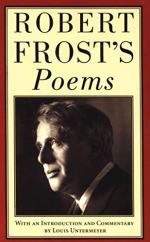
|
| Name: _________________________ | Period: ___________________ |
This test consists of 15 multiple choice questions and 3 short answer questions.
Multiple Choice Questions
1. What techniques are used in the lines "Possessing what we still were unpossessed by,/ Possessed by what we now no more possessed" (lines 6-7)?
(a) Chiasmus and antithesis.
(b) Antithesis and oxymoron.
(c) Epistrophe and chiasmus.
(d) Oxymoron and epistrophe.
2. What is alluded to in the phrase "the land vaguely realizing westward" (line 14)?
(a) The American Civil War.
(b) The Louisiana Purchase.
(c) The Westward expansion of the United States.
(d) The forced resettlement of Native peoples.
3. To what event does the phrase "more than a hundred years/ Before we were her people" obliquely refer?
(a) The Pilgrims' first landing.
(b) The American Revolution.
(c) The American Civil War.
(d) Columbus's voyage.
4. Which term most accurately describes the meter of "The Gift Outright"?
(a) Heroic verse.
(b) Free verse.
(c) Blank verse.
(d) Ballad meter.
5. What technique is used in the lines "She was our land more than a hundred years/ Before we were her people" (lines 2-3)?
(a) Symbolism.
(b) Metonymy.
(c) Personification.
(d) Alliteration.
6. Which is the primary definition of "still" being used in the expression "still colonials" in line 5?
(a) Nevertheless.
(b) Quiet.
(c) Continuing to be.
(d) Unmoving.
7. What technique is used in the line "Such as she was, such as she would become" (line 16)?
(a) Anadiplosis.
(b) Symbolism.
(c) Anaphora.
(d) Chiasmus.
8. What technique is used in the phrase "unstoried, artless, unenhanced" (line 15)?
(a) Assonance.
(b) Euphemism.
(c) Asyndeton.
(d) Apostrophe.
9. Who is the author of "The Gift Outright"?
(a) Donald Hall.
(b) Robert Frost.
(c) Robert Lowell.
(d) Galway Kinnell.
10. Which technique is used in the first line, "The land was ours before we were the land’s"?
(a) Allegory.
(b) Chiasmus.
(c) Anaphora.
(d) Euphemism.
11. What does line 12 make clear is the "Gift" in the title "The Gift Outright"?
(a) Surrender and salvation.
(b) The land Americans live on.
(c) Americans themselves.
(d) Freedom from England.
12. What is the implied antecedent of "our" and "we" in lines 1 and 2?
(a) Americans.
(b) Revolutionaries.
(c) Farmers.
(d) Colonists.
13. In line 15, what is the speaker calling "unstoried, artless, unenhanced"?
(a) The American people.
(b) The wars fought to secure land.
(c) The history of the United States.
(d) The American land.
14. What is the antecedent of "it" in the phrase "it was ourselves" (line 9)?
(a) "What we now no more possessed" (line 7).
(b) "Still colonials" (line 5).
(c) "What we still were unpossessed by" (line 6).
(d) "Something we were withholding" (line 8).
15. What techniques are used in the lines "She was ours/ In Massachusetts, in Virginia" (lines 3-4)?
(a) Asyndeton and apostrophe.
(b) Antithesis and synecdoche.
(c) Synecdoche and asyndeton.
(d) Apostrophe and antithesis.
Short Answer Questions
1. The repetition of the word "deed" in line 13 is an example of which technique?
2. What technique is used in line 10, "We were withholding from our land of living"?
3. According to the poem's second sentence, how did "we" find "salvation"?
|
This section contains 449 words (approx. 2 pages at 300 words per page) |

|




